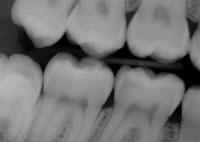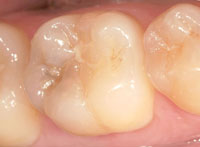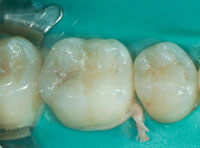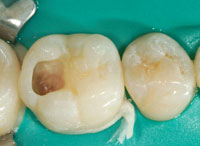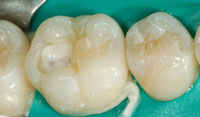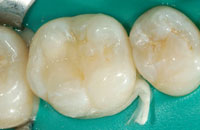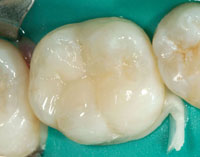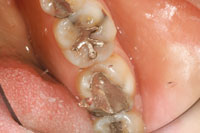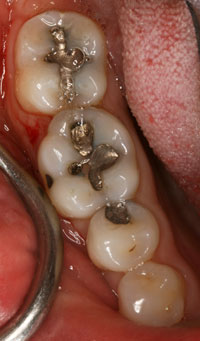|
INTRODUCTION
With the numerous array of composite materials on the market, how do we make a rational choice for our patients? The handling of the material and aesthetics are important, but the bond strength and postoperative sensitivity are also critical to produce a predictable result. Further improvements in polymerization shrinkage, flexural strength, bond strength, and color matrix have resulted in the nanocomposites providing a highly aesthetic and healthy restorative option.
CASE PRESENTATION
A 23-year-old male presented with pain on chewing and cold stimulation in the lower right mandible. Radiographic evaluation revealed a carious lesion involving the dentin on tooth No. 30 (Figure 1). An evaluation of the occlusal relationship demonstrated stable centric contacts could be achieved on both the remaining tooth structure and the restoration (Figure 2). A direct composite restoration was selected since this could conserve remaining tooth structure after caries removal, compared to other indirect restorations such as a gold or porcelain inlay.
THE TECHNIQUE
Rubber dam (DermaDam [Ultradent Products]) isolation was achieved (Figure 3) and all caries were removed without any pulpal exposure. Due to the extent of carious involvement of the cemento-enamel junction (CEJ), unsupported occlusal enamel was removed to facilitate evaluation of complete caries removal at the CEJ. The distal marginal ridge was preserved, as there was adequate thickness of remaining enamel and the bonded composite restoration would reinforce the enamel. All residual sealant was removed from the occlusal aspect to thoroughly evaluate the grooves for any recurrent decay (Figure 4).
After etching with a 35% phosphoric acid, the cavity was dried carefully without desiccating the dentin. The bonding agent iBOND Total Etch (Heraeus Kulzer) was then applied in a single layer for 20 seconds. The desensitization properties of this bonding agent were beneficial, because a single application facilitated the priming, bonding, and desensitization of the preparation. A gentle airstream allowed removal of the ethanol solvent and adequate thinning to prevent any pooling in the corners of the cavity. Polymerization was completed with a LED polymerization light (Demi [SDS Kerr]) for 20 seconds. The white base liner (Venus Diamond baseliner [Heraeus Kulzer]) was utilized since the low viscosity material adapts easily to the internal aspect of the preparation to ensure complete sealing of the base dentin (Figure 5). Next, A1 universal Venus Diamond composite (Heraeus Kulzer) was condensed in 2 layers to ensure adequate polymerization of each 2.0 mm layer. The unique monomer system of this nanocomposite (tricyclodecane-urethane) exhibits low polymerization shrinkage, which decreases the stresses generated on the tooth/restoration bond interface, and good viscosity for material handling. The author has found that the material does not adhere to instrumentation during sculpturing. It is reported to exhibit high flexural strength after polymerization due to a high conversion rate (Figure 6).
Regional anatomy was easily carved into the occlusal aspect and a final amber translucent layer (Venus Diamond Amber Translucent) was applied to complete the final shade match. This layer was thinner than the surrounding enamel thickness (0.5 mm) in order to simulate the surrounding translucency and recreate the optical properties of the tooth. The refractive index of the matrix and nanofillers in this composite resin material allows an ideal color adaptation to the tooth with the ability to achieve a “chameleon effect.”
The restoration was polished (Venus Supra [Heraeus Kulzer]) after preliminary finishing was accomplished using diamond burs (ET Diamond: DET6F, DOS1F [Brasseler USA]). The 2-step polishing procedure shortens the polishing process, while imparting an exceptional shine. The prepolish did not remove a lot of composite material but was effective at removing the surface imperfections. The high gloss polisher imparted a high luster to achieve a natural and aesthetic appearance and minimize future plaque and stain accumulation.
The final restoration blended seamlessly into the neighboring dentition to create a virtually invisible restoration (Figure 7). The patient reported no postoperative sensitivity and was extremely satisfied with the direct composite restoration.
CONCLUSION
The improved nanocomposite resin materials offer a reliable and conservative treatment option for our patients; especially when the restoration is of a limited size and can be adequately bonded to enamel. Appropriate case selection and impeccable execution of the bonding process will result in a biologically, mechanically, and functionally ideal restoration that is highly aesthetic.
Dr. Wu earned a DDS degree at the University of Tennessee and was an instructor and lecturer in the Restorative Dentistry Department. Dr. Wu is on faculty with the Newport Coast Oral Facial Institute, a nonprofit international teaching and research center. Dr. Wu is a member of the ADA, the California Dental Association, the Orange County Dental Society, the American College of Maxillofacial Prosthetics, and the Royal Australasian College of Dental Surgeons. She is also actively involved with several research projects on dental implants and materials, and has published articles in several dental journals. She can be reached via e-mail at jcwu@ncofi.org.
Disclosure: Dr. Wu has received financial reimbursement for product evaluations.



